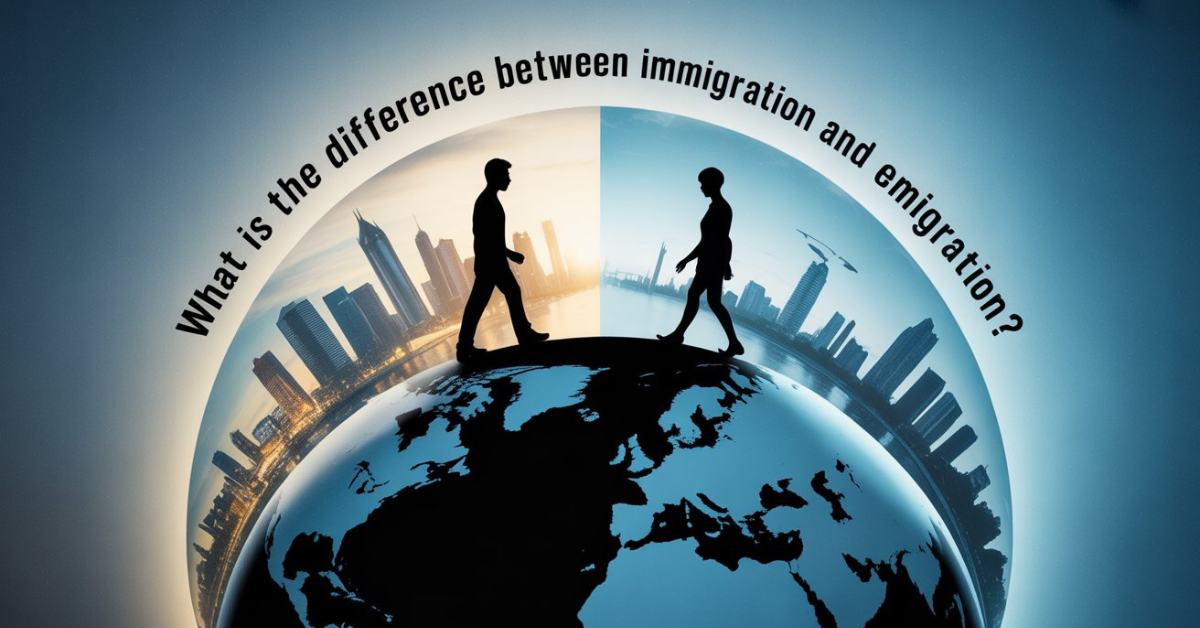Understanding the concepts of immigration and emigration is essential in today’s globalized society. These terms describe two sides of the same process—people moving from one place to another—but they are used in different contexts depending on perspective. This distinction is vital in fields such as international law, economics, sociology, and even politics, as each term carries its own implications.
Definition of Immigration
Immigration refers to the act of entering and settling in a country other than one’s native country with the intention of residing there permanently or for an extended period. From the perspective of the receiving country, a person who moves into its borders is considered an immigrant. Immigration can be driven by numerous factors, including:
- Economic opportunities (seeking better employment or career growth)
- Educational advancement (enrolling in foreign universities or institutions)
- Political stability and safety (escaping conflict or persecution)
- Family reunification (joining relatives who already reside in the destination country)
For example, when a person from India moves to the United States to work as a software engineer, from the U.S. perspective, they are immigrating to America.
Definition of Emigration
Emigration is the act of leaving one’s native country to live in another country. From the point of view of the country of origin, the individual is considered an emigrant. Emigration focuses on the departure rather than the arrival. Common reasons for emigration include:
- Economic challenges in the home country
- Better quality of life abroad
- Educational opportunities elsewhere
- Political instability or oppression in the homeland
For example, the same individual from India who moves to the U.S. is an emigrant from India’s perspective.
Historical Examples
-
Irish Emigration (19th Century): Millions left Ireland during the Great Famine, primarily for the United States.
-
U.S. Immigration Waves: The late 1800s and early 1900s saw large numbers arriving from Europe, shaping American society.
-
Syrian Refugee Crisis: Millions emigrated due to conflict, with many immigrating to European and Middle Eastern countries
Key Difference Between Immigration and Emigration
The main difference lies in perspective:
- Immigration = entering a foreign country to live there.
- Emigration = leaving one’s own country to live abroad.
In simple terms, immigration is about arriving, and emigration is about departing.
Reasons for Immigration and Emigration
Common Immigration Drivers
-
Economic Opportunities – Higher wages, better career growth, and business prospects.
-
Education – Access to world-class institutions and research facilities.
-
Safety and Stability – Escape from war, crime, or political persecution.
-
Family Reunification – Joining relatives already settled abroad.
Common Emigration Drivers
-
Limited Job Prospects – Leaving to seek better employment abroad.
-
Political or Social Instability – Avoiding conflict or discrimination.
-
Environmental Factors – Climate change, natural disasters, or resource scarcity.
-
Personal Aspirations – Desire for travel, cultural experiences, or personal growth.
Immigration vs. Emigration: Comparative Table
| Criteria | Immigration | Emigration |
|---|---|---|
| Direction of Movement | Into a country | Out of a country |
| Perspective | Destination country’s point of view | Country of origin’s point of view |
| Focus | Arrival and settlement | Departure and relocation |
| Example | A Nigerian moving to Canada is an immigrant in Canada | The same Nigerian is an emigrant from Nigeria |
The Role of Immigration and Emigration in Global Movement
Global migration is a two-way process. Every immigrant in one country is simultaneously an emigrant from another. This dual nature is critical in understanding migration patterns, economic impact, and demographic changes.
Immigration and Emigration in Global Context
Global migration patterns have existed for centuries, but in the modern era, they are influenced by economic opportunities, political instability, environmental changes, and globalization. The United Nations International Organization for Migration (IOM) tracks millions of movements annually, highlighting the importance of understanding these terms correctly.
-
Immigration Trends: Many developed nations experience steady immigration due to job availability, better education, and higher living standards.
-
Emigration Trends: Countries experiencing political unrest, conflict, or lack of economic prospects often have higher emigration rates.
Push and Pull Factors in Migration
The decision to immigrate or emigrate is often influenced by push factors (conditions that drive people away from their home country) and pull factors (conditions that attract people to a new country).
Push Factors:
- Unemployment or underemployment
- Political instability
- Poor infrastructure and services
- Environmental disasters
Pull Factors:
- Job opportunities and higher wages
- Political freedom and safety
- Better education and healthcare
- Advanced infrastructure
Economic Impact of Immigration
From the viewpoint of the receiving country, immigration can bring multiple benefits:
- Filling labor shortages in specific industries
- Boosting innovation through diverse skill sets
- Increasing consumer demand, stimulating economic growth
- Cultural diversity, enriching the social fabric
However, challenges may include pressure on housing, healthcare, and public services, as well as debates over immigration policy and integration.
Economic Impact of Emigration
For the sending country, emigration can have both positive and negative outcomes:
- Positive: Remittances from emigrants can support families and boost local economies.
- Negative: Brain drain can occur if a significant number of skilled workers leave, impacting the country’s workforce and development potential.
Legal and Policy Differences
Immigration policies focus on regulating who can enter and stay in a country, under what conditions, and for how long. This includes:
- Visa requirements
- Residency permits
- Work authorization
- Citizenship pathways
Emigration policies, while less common, may regulate who can leave, sometimes for reasons of national security or economic protection.
Case Study: The United States and India
If a professional from India relocates to the United States for work:
- From the U.S. perspective: They are an immigrant.
- From the Indian perspective: They are an emigrant.
This duality illustrates that the same movement can be described differently depending on the viewpoint.
How Immigration and Emigration Interconnect
Though they are opposites in definition, immigration and emigration are two sides of the same process. Every emigration from one country is simultaneously an immigration into another.
For instance, when someone emigrates from Mexico, they are immigrating into the United States. Understanding this connection clarifies global migration flows and helps policymakers address both ends of the migration spectrum.
Impact on Societies
On the Host Country (Immigration)
-
Economic Growth – Immigrants often contribute to GDP through labor and entrepreneurship.
-
Cultural Diversity – Broader cultural representation enriches the community.
-
Social Challenges – Integration policies, language barriers, and housing demand.
On the Origin Country (Emigration)
-
Loss of Talent – Skilled professionals leaving may slow development.
-
Remittances – Money sent home supports families and boosts the local economy.
-
Population Shifts – Changes in demographic structure, often leading to aging populations.
Legal and Administrative Processes
Immigration and emigration both require legal procedures that differ between countries:
-
Immigration Requirements: Visas, work permits, residency cards, background checks, and sometimes language proficiency tests.
-
Emigration Requirements: Some countries require exit permits, tax clearance, or mandatory military service clearance before departure.
Common Misconceptions
- Immigration and emigration are the same thing – They are related but not identical; the difference is purely one of perspective.
- Only permanent relocation counts – Short-term stays for work or study can also involve immigration or emigration, depending on the legal definitions of the countries involved.
- Migrants are always unskilled – Many migrants are highly skilled professionals seeking better opportunities abroad.
Conclusion
In essence, immigration is about moving into a country, while emigration is about moving out of a country. These two terms represent the opposite perspectives of the same human movement. Whether driven by economic prospects, education, safety, or family ties, migration continues to shape societies, economies, and cultures worldwide. Understanding this distinction is not only important for clarity in conversation but also for making informed decisions in global policy and international relations.




